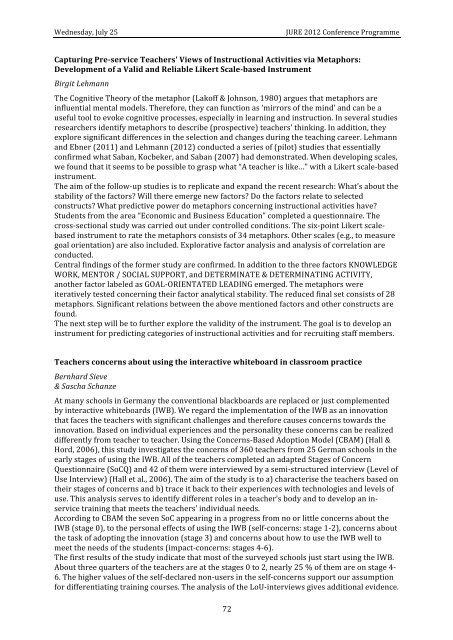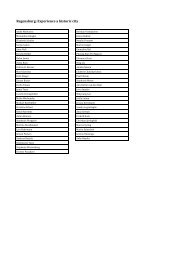JURE 2012 Programme book - EARLI Jure 2012
JURE 2012 Programme book - EARLI Jure 2012
JURE 2012 Programme book - EARLI Jure 2012
Create successful ePaper yourself
Turn your PDF publications into a flip-book with our unique Google optimized e-Paper software.
Wednesday, July 25 <strong>JURE</strong> <strong>2012</strong> Conference <strong>Programme</strong><br />
Capturing Pre-‐service Teachers' Views of Instructional Activities via Metaphors:<br />
Development of a Valid and Reliable Likert Scale-‐based Instrument<br />
Birgit Lehmann<br />
The Cognitive Theory of the metaphor (Lakoff & Johnson, 1980) argues that metaphors are<br />
influential mental models. Therefore, they can function as ‘mirrors of the mind’ and can be a<br />
useful tool to evoke cognitive processes, especially in learning and instruction. In several studies<br />
researchers identify metaphors to describe (prospective) teachers’ thinking. In addition, they<br />
explore significant differences in the selection and changes during the teaching career. Lehmann<br />
and Ebner (2011) and Lehmann (<strong>2012</strong>) conducted a series of (pilot) studies that essentially<br />
confirmed what Saban, Kocbeker, and Saban (2007) had demonstrated. When developing scales,<br />
we found that it seems to be possible to grasp what “A teacher is like…” with a Likert scale-‐based<br />
instrument.<br />
The aim of the follow-‐up studies is to replicate and expand the recent research: What’s about the<br />
stability of the factors? Will there emerge new factors? Do the factors relate to selected<br />
constructs? What predictive power do metaphors concerning instructional activities have?<br />
Students from the area “Economic and Business Education” completed a questionnaire. The<br />
cross-‐sectional study was carried out under controlled conditions. The six-‐point Likert scale-‐<br />
based instrument to rate the metaphors consists of 34 metaphors. Other scales (e.g., to measure<br />
goal orientation) are also included. Explorative factor analysis and analysis of correlation are<br />
conducted.<br />
Central findings of the former study are confirmed. In addition to the three factors KNOWLEDGE<br />
WORK, MENTOR / SOCIAL SUPPORT, and DETERMINATE & DETERMINATING ACTIVITY,<br />
another factor labeled as GOAL-‐ORIENTATED LEADING emerged. The metaphors were<br />
iteratively tested concerning their factor analytical stability. The reduced final set consists of 28<br />
metaphors. Significant relations between the above mentioned factors and other constructs are<br />
found.<br />
The next step will be to further explore the validity of the instrument. The goal is to develop an<br />
instrument for predicting categories of instructional activities and for recruiting staff members.<br />
Teachers concerns about using the interactive whiteboard in classroom practice<br />
Bernhard Sieve<br />
& Sascha Schanze<br />
At many schools in Germany the conventional blackboards are replaced or just complemented<br />
by interactive whiteboards (IWB). We regard the implementation of the IWB as an innovation<br />
that faces the teachers with significant challenges and therefore causes concerns towards the<br />
innovation. Based on individual experiences and the personality these concerns can be realized<br />
differently from teacher to teacher. Using the Concerns-‐Based Adoption Model (CBAM) (Hall &<br />
Hord, 2006), this study investigates the concerns of 360 teachers from 25 German schools in the<br />
early stages of using the IWB. All of the teachers completed an adapted Stages of Concern<br />
Questionnaire (SoCQ) and 42 of them were interviewed by a semi-‐structured interview (Level of<br />
Use Interview) (Hall et al., 2006). The aim of the study is to a) characterise the teachers based on<br />
their stages of concerns and b) trace it back to their experiences with technologies and levels of<br />
use. This analysis serves to identify different roles in a teacher’s body and to develop an in-‐<br />
service training that meets the teachers’ individual needs.<br />
According to CBAM the seven SoC appearing in a progress from no or little concerns about the<br />
IWB (stage 0), to the personal effects of using the IWB (self-‐concerns: stage 1-‐2), concerns about<br />
the task of adopting the innovation (stage 3) and concerns about how to use the IWB well to<br />
meet the needs of the students (impact-‐concerns: stages 4-‐6).<br />
The first results of the study indicate that most of the surveyed schools just start using the IWB.<br />
About three quarters of the teachers are at the stages 0 to 2, nearly 25 % of them are on stage 4-‐<br />
6. The higher values of the self-‐declared non-‐users in the self-‐concerns support our assumption<br />
for differentiating training courses. The analysis of the LoU-‐interviews gives additional evidence.<br />
72



